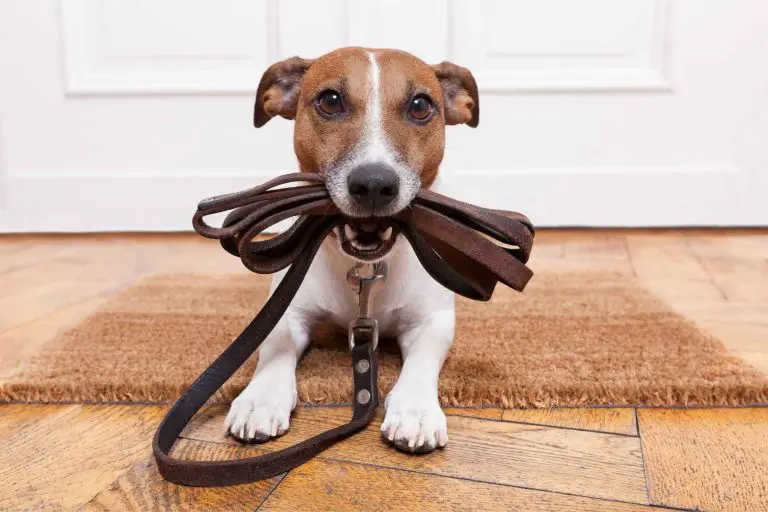Why Does My Dog Stand Over My Other Dog?

Your dog may be standing over your other dog as a way of asserting dominance. Standing over a dog that is laying down or placing its chin or paws on another dog is a form of showing a higher social ranking in the “pack.” Turning their side towards another dog is a way of showing they have a lower social hierarchy.
Keep reading to learn more about how your dogs communicate dominance to each other and some tips for how to level the playfield so your dogs see each other more as equals.
How Do Dogs Show Dominance Over Other Dogs?
One of the most obvious ways a dog shows its dominance over other dogs is through aggressive behavior such as biting and otherwise trying to “herd” the dogs.
However, there are some other more subtle signs that you should look for if you want to keep the peace between your dogs.
Dogs show dominance by:
- Standing over the other dog or putting their paws on them.
- Guarding their owner against other dogs.
- Stealing attention from other dogs.
- Refusing to move off furniture or out of another dog’s way.
- Stealing or hoarding toys from other dogs.
- Must walk in front of the other dog either into another room or while walking on a leash.
Some of these you might not notice until you know to look for them, so be sure that you know the signs so you can watch out for any unwanted dominating behavior.
What Causes Dominating Behavior Over Other Dogs?
Some dog owners assume that some dogs are more dominant than others, and while there may be a few cases where this is true, most of the time, a dog becomes dominant because no one has told them not to behave that way.
The main reasons for dominant behavior are:
- Lack of socializing with other dogs: If your dog isn’t used to being around other dogs, they are more likely to feel territorial when introduced to their home.
- Lack of training: If your dog doesn’t have the training not to have dominant behavior, they are more likely to fall back on it.
- Environment factors: There may be something in their environment that they are feeling threatened by, and they want to assert their dominance as a result.
Remember that if you are introducing a new dog into your home, you are bound to have a period where the dog you already have exhibited dominant behavior over the new dog. Your first dog will feel territorial about their home and you as they’re not used to sharing that space and attention. Ensure you are saying “no” to this behavior, and it should pass as they adjust.
There are some cases where a dog is behaving dominantly because of an underlying illness that can affect hormones. If you suspect that this might be the reason for your dog’s behavior, then see your vet as soon as possible so they can see what the problem might be.
How Do I Stop My Dog From Dominating Other Dogs?
Now that you can identify the signs of dominant behavior and understand what is causing it, it’s time to correct the behavior before it becomes a habit. Ultimately, you are the pack leader so what you say goes.
To stop dominant behavior:
- Be calm but assertive. Dogs don’t like inconsistency, and a dominant dog will try to correct any unbalanced behavior they see. You need to always stick to your house’s rules and never give commands that feel nervous or anxious. When you tell them to stop their dominating behavior, your dog must listen.
- Set rules and boundaries and stick to them. If they aren’t allowed on a piece of furniture, they are never let on that piece regardless of other circumstances. If they can’t have food unless they are calm, they must always be calm before getting food. If they’re not allowed to stand over your other dog, never let it slide.
- Don’t force affection. If your dog is being aloof towards you or your other dog, don’t try to force your dogs to play together or play with you. Trying to please your dog is a sign of a follower and not a leader, so it’s better to let them be aloof, and they will come around eventually.
- Take advantage of mealtime. Leaders eat first, so make sure you aren’t feeding one of your dogs before the other. Put food in both their bowls while they are still out of reach, then place them within reach simultaneously. It would be best to reinforce boundaries, so one dog isn’t trying to eat the other’s food.
- Give them time to get to know each other. If you introduce a new dog to your home, it might take some time before the two dogs see each other as equals. Let them spend some time together and figure out how they feel about each other. You may find that the dominating behavior lessens once they know each other better.
If the problem gets worse or it doesn’t seem to be changing with your interventions, it may be time to look into hiring a professional dog trainer who can help you through the process of asserting yourself as the leader. A well-trained dog should obey your commands and see you as the one in charge.
Which Dog Breeds are the Most Dominant?
Dominate behavior can accord in any breed of dog, whether male or female, but it is more common in males. Dominant behavior can start appearing when the dog reaches maturity, usually around three years old.
The most common breeds to have dominance issues are:
- Boerboels
- They make fantastic guard dogs as they are territorial and generally suspicious of strangers.
- Giant Schnauzers
- They are shy and suspicious around strange and take a lot of socialization to overcome aggressive behavior towards others.
- Siberian Huskies
- They are independent and stubborn and want to assert themselves by testing boundaries and ignoring commands.
- Caucasian Shepherd Dogs
- They are territorial and have a history of herding, making them prone to wanting to take control of other animals around them.
- American Bulldogs
- They have a history of baiting Bulls which explains their fierce nature and need to protect their territory.
- Neapolitan Mastiffs
- They are one of the largest breeds in the world and like to test boundaries, but mostly they are very protective of their family.
- Dogo Argentinos
- They have the instinct to chase smaller animals, including cats and other dogs, but they will never attack unprovoked.
- Jack Russel Terriers
- They are a big dog in a small body with enough stubbornness for two dogs, and they rarely get along well with other dogs.
With the proper training, any dog can overcome their natural tendency towards dominating behavior, and usually, they will be delighted to have another dog as a companion.
Final Thoughts
If your dog is standing over our other dog when they’re laying down or while playing, then it’s probably because your dog is trying to assert their dominance over the other.
It’s common for dogs to use dominating behavior over new dogs to their home or younger dogs, but it can quickly become a problem if you don’t train them out of it.






